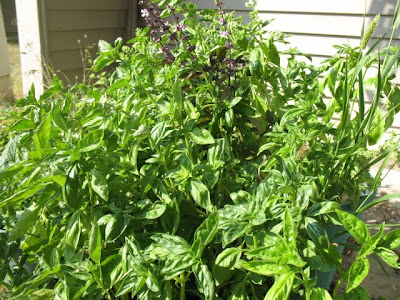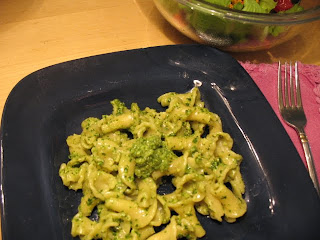
Last year, my aunt, upon gazing at my patio garden, asked if I thought I had enough basil. I’m always a little worried that there won’t be enough for a year’s supply of frozen pesto, so it took me a few moments to realize she was teasing me. And, yes, I had enough basil. I had more than enough basil. I still have pesto in the freezer from last year’s harvest. …And I did it all over again this year.
I don’t buy fresh basil in the “off season.” It’s pretty expensive, and probably came from far away. To me, basil is summer food and I try to get as much out of the season as I can. Dishes like Pasta with Cherry Tomatoes, Olives and Basil just have to wait for basil season. When its growing on the porch, I put fresh basil (as well as oregano, rosemary and thyme) in pizza and pasta sauces (like this simple one) where I would usually use it dried the rest of the year.
the season as I can. Dishes like Pasta with Cherry Tomatoes, Olives and Basil just have to wait for basil season. When its growing on the porch, I put fresh basil (as well as oregano, rosemary and thyme) in pizza and pasta sauces (like this simple one) where I would usually use it dried the rest of the year.
 the season as I can. Dishes like Pasta with Cherry Tomatoes, Olives and Basil just have to wait for basil season. When its growing on the porch, I put fresh basil (as well as oregano, rosemary and thyme) in pizza and pasta sauces (like this simple one) where I would usually use it dried the rest of the year.
the season as I can. Dishes like Pasta with Cherry Tomatoes, Olives and Basil just have to wait for basil season. When its growing on the porch, I put fresh basil (as well as oregano, rosemary and thyme) in pizza and pasta sauces (like this simple one) where I would usually use it dried the rest of the year.A die hard basil farmer like myself, however, would be lost (in the basil jungle) without pesto. It is the only recipe I know that uses enough basil to put a dent in my over-exuberant crop. There’s an added bonus to making pesto, too. It can easily be packaged and frozen, extending the season of pure basil satisfaction for many months …or until you’re really tired of pesto.
 I wasn’t going to post a pesto recipe, since there are a zillion of them that you can find anywhere from your Italian grandmother’s recipe box (okay, so she probably doesn’t refer to a recipe, but you get the point) to the latest internet recipe sites. Besides, I rarely measure anything when making pesto, and really just cram a bunch of basil into the food processor with some parsley (I like the balance in flavor between the two herbs), Parmigiano-Reggiano cheese, walnuts (you could use pine nuts, which are more traditional, or almonds), garlic, salt and olive oil, and process it into submission. I decided to make this post anyway, since The Messy Apron is really a recipe and cooking journal, and this is what I’m doing this week. I’ve tried to approximate the amounts I used in my most recent batch of the green stuff in the recipe below.
I wasn’t going to post a pesto recipe, since there are a zillion of them that you can find anywhere from your Italian grandmother’s recipe box (okay, so she probably doesn’t refer to a recipe, but you get the point) to the latest internet recipe sites. Besides, I rarely measure anything when making pesto, and really just cram a bunch of basil into the food processor with some parsley (I like the balance in flavor between the two herbs), Parmigiano-Reggiano cheese, walnuts (you could use pine nuts, which are more traditional, or almonds), garlic, salt and olive oil, and process it into submission. I decided to make this post anyway, since The Messy Apron is really a recipe and cooking journal, and this is what I’m doing this week. I’ve tried to approximate the amounts I used in my most recent batch of the green stuff in the recipe below.Really, the pesto technique can be used with many different herbs and other green leaves as well as other kinds of nuts. I’ve seen recipes (and tried many of them) with arugula, spinach, cilantro and mint (one of my favorites), and sage, as well as with other nuts, such as macadamias and pistachios. I suppose the possibilities depend mostly on your personal taste, and what you planted too much of this year.
Now, if you’ll excuse me, I’ve got to take my machete back out to harvest the jungle and make some more pesto!

Basic Basil Pesto
This recipe makes a relatively thick pesto. If you like it thinner, simply add more olive oil.
3 cups basil leaves
1 cup parsley leaves
½ cup grated Parmesan cheese
½ cup walnuts, toasted
4 cloves garlic
2 teaspoons coarse salt
¼ cup olive oil, preferably extra-virgin
1. Place basil, parsley, Parmesan cheese, walnuts, garlic and salt in a food processor. Process until everything is well ground into a coarse paste.
2. With the processor running, slowly add the olive oil and process until completely smooth. Add more olive oil if the pesto is too thick.
To serve, toss pesto with hot pasta. Thin with a little pasta cooking water if desired. You can also add pesto to soups, spread it on garlic bread or pizza, or add it to sauces.
The pesto will turn a very dark green, almost brown color after storing. This is natural and still tastes good. Pouring a thin layer of olive oil over the stored pesto can help keep it bright green.
To freeze pesto, portion it out into plastic bags or freezable containers. Seal them into a freezer bag and freeze for a few months (or probably longer). You can also freeze small portions in ice cube trays.




No comments:
Post a Comment